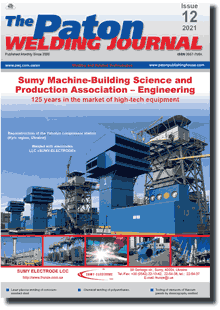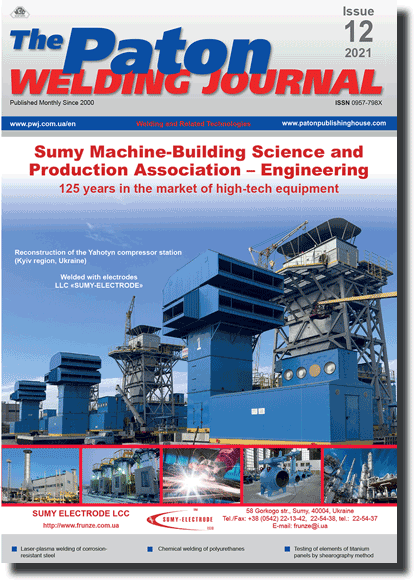| 2021 №12 (05) |
DOI of Article 10.37434/tpwj2021.12.06 |
2021 №12 (07) |

The Paton Welding Journal, 2021, #12, 36-40 pages
Chemical welding of polyurethanes and their composites
A. Vashchuk1, M. Iurzhenko1, M. Korab1, Е. Privalko2
1E.O. Paton Electric Welding Institute of the NASU. 11 Kazymyr Malevych Str., 03150, Kyiv, Ukraine. E-mail: alina.vashchuk@i.ua
2O.O. Bogomolets National Medical University 13 Shevchenko Blvd, 01601, Kyiv, Ukraine
Abstract
Chemical welding as an attractive alternative to classical joining techniques occurs through the formation of new chemical bonds between neighboring molecules at the contacting surfaces to be joined. This review paper presents the current state of the chemical welding of polyurethanes and their composites via dynamic covalent bonds. The strength of welded joints obtained by different welding technologies was compared. Different processing parameters affecting the joint quality, namely welding time and welding temperature were summarized. The future perspectives of chemical welding of polyurethanes and their composites were discussed in the paper.
Keywords: polyurethanes, composites, chemical welding
Received 05.10.2021
Accepted: 24.12.2021
References
1. Privalko, V.P., Privalko, E.G., Shtompel, V.I. et al. (1999) Influence of the structure of soft and stiff chain fragments on properties of segmented polyurethanes. I. Phase morphology. Polymer Engineering & Sci., 39, 1534-1540. https://doi.org/10.1002/pen.115462. Zdrahala, R.J., Zdrahala, I.J. (1999). Biomedical applications of polyurethanes: A review of past promises, present realities, and a vibrant future. J. of Biomaterials Applications, 14, 67-90. https://doi.org/10.1177/088532829901400104
3. Georgoussis, G., Kyritsis, A., Pissis, P. et al. (1999) Dielectric studies of molecular mobility and microphase separation in segmented polyurethanes. European Polymer J., 35, 2007- 2017. https://doi.org/10.1016/S0014-3057(98)00288-2
4. Yan, P., Zhao, W., Fu, X. et al. (2017) Multifunctional polyurethane- vitrimers completely based on transcarbamoylation of carbamates: thermally-induced dual-shape memory effect and self-welding. RSC Advances, 7, 26858-26866. https://doi.org/10.1039/C7RA01711A
5. Zheng, N., Hou, J., Xu, Y. et al. (2017) Catalyst-free thermoset polyurethane with permanent shape reconfigurability and highly tunable triple-shape memory performance. ACS Macro Letters, 6, 326-330. https://doi.org/10.1021/acsmacrolett.7b00037
6. Jiang, L., Liu, Z., Lei, Y. et al. (2019) Sustainable thermosetting polyurea-vitrimers based on a catalyst-free process with reprocessability, permanent shape reconfiguration and self-healing performance. ACS Applied Polymer Materials, 1, 3261-3268. https://doi.org/10.1021/acsapm.9b00672
7. Yan, P., Zhao, W., Fu, X. et al. (2017) Multifunctional polyurethane- vitrimers completely based on transcarbamoylation of carbamates: Thermally-induced dual-shape memory effect and self-welding. RSC Advances, 7, 26858-26866. https://doi.org/10.1039/C7RA01711A
8. Gamardella, F., Guerrero, F., De la Flor, S. et al. (2019) A new class of vitrimers based on aliphatic poly(thiourethane) networks with shape memory and permanent shape reconfiguration. European Polymer J., 122, 109361. https://doi.org/10.1016/j.eurpolymj.2019.109361
9. Habault, D., Zhang, H., Zhao, Y. (2013) Light-triggered self-healing and shape-memory polymers. Chemical Society Reviews, 42, 7244-7256. https://doi.org/10.1039/c3cs35489j
10. Yang, Y., Pei, Z., Li, Z. et al. (2016) Making and remaking dynamic 3D structures by shining light on flat liquid crystalline vitrimer films without a mold. J. of the American Chemical Society, 138, 2118-2121. https://doi.org/10.1021/jacs.5b12531
11. Mizuno, K., Ishii, J., Kishida, H. et al. (2009) A black body absorber from vertically aligned single-walled carbon nanotubes. Proc. of the National Academy of Sci., 106, 6044-6047. https://doi.org/10.1073/pnas.0900155106
12. Yan, P., Zhao, W., Wang, Y. et al. (2017) Carbon nanotubes- polyurethane vitrimer nanocomposites with the ability of surface welding controlled by heat and near-infrared light. Macromolecular Chemistry and Physics, 218, 1700265. https://doi.org/10.1002/macp.201700265
Suggested Citation
A. Vashchuk, M. Iurzhenko, M. Korab, Е. Privalko (2021) Chemical welding of polyurethanes and their composites. The Paton Welding J., 12, 36-40.The cost of subscription/purchase order journals or individual articles
| Journal/Currency | Annual Set | 1 issue printed |
1 issue |
one article |
| TPWJ/USD | 384 $ | 32 $ | 26 $ | 13 $ |
| TPWJ/EUR | 348 € | 29 € | 24 € | 12 € |
| TPWJ/UAH | 7200 UAH | 600 UAH | 600 UAH | 280 UAH |
| AS/UAH | 1800 UAH | 300 UAH | 300 UAH | 150 UAH |
| AS/USD | 192 $ | 32 $ | 26 $ | 13 $ |
| AS/EUR | 180 € | 30 € | 25 € | 12 € |
| SEM/UAH | 1200 UAH | 300 UAH | 300 UAH | 150 UAH |
| SEM/USD | 128 $ | 32 $ | 26 $ | 13 $ |
| SEM/EUR | 120 € | 30 € | 25 € | 12 € |
| TDNK/UAH | 1200 UAH | 300 UAH | 300 UAH | 150 UAH |
| TDNK/USD | 128 $ | 32 $ | 26 $ | 13 $ |
| TDNK/EUR | 120 € | 30 € | 25 € | 15 € |
AS = «Automatic Welding» - 6 issues per year;
TPWJ = «PATON WELDING JOURNAL» - 12 issues per year;
SEM = «Electrometallurgy Today» - 4 issues per year;
TDNK = «Technical Diagnostics and Non-Destructive Testing» - 4 issues per year.


